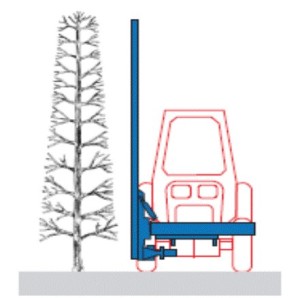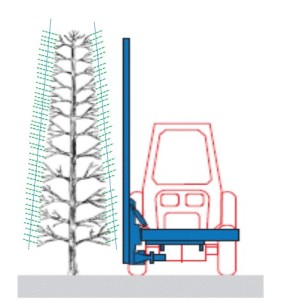Reducing Pruning Costs Through Mechanization

Figure 1: The “box” concept: a system where hedging is conducted at the end of the dormant season to pre-form the trees into “box” shape.
Lamont Fruit Farms has successfully implemented sidewall shearing. At this site with a very narrow fruiting wall and super spindle trees, hedging has been conducted 12 inches from the trunk of Gala, Honeycrisp, and SweeTango the last two years, and this year to Fuji, Zestar!, Acey Mac, Macoun, and Pinova trees. They have developed a system where hedging is conducted at the end of the dormant season or at pink to pre-form the trees into a shape or “box” so that later summer hedging does not cut off fruits (Figure 1). From the pre-formed “box” shoots grow during the season until they are hedged again in late July or early August at 14 inches from the trunk (Figure 2).

Figure 2: From the pre-formed “box” shape, shoots (in green color) grow during the season until they are hedged again in the summer. (Graphic courtesy of Mario Miranda Sazo)
This spring, another 30-acre orchard site of mature tall spindle Gala trees was hedged at 24 inches from the trunk to form or establish the “box” concept (Figure 1). Hedging occurred in the late winter after the removal of big wood through limb renewal pruning. The pruning of the tops was conducted manually after hedging and it left a manicured fruiting wall with a very narrow top. The shoots coming from the “box” were hedged again in the summer of 2015 at 26-28 inches from the trunk (Figure 2).
The cost and time for summer hedging amounted to a fraction of the time — about 5% — compared to manual summer pruning with loppers and ladders. If sidewall shearing in the summer can reduce summer pruning costs by 95% and improve labor efficiency without negative effects on return bloom, vigorous growth response, or a significant yield reduction, it will also have a significant impact on orchard profitability.










